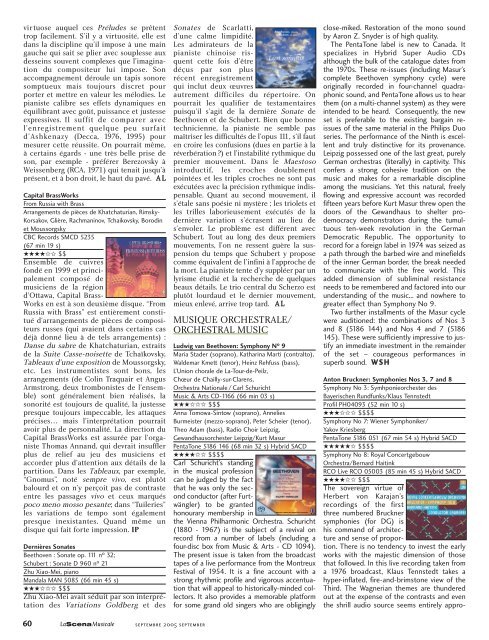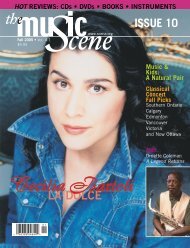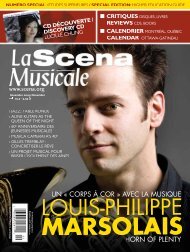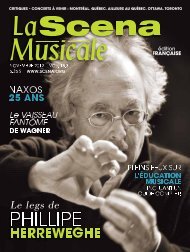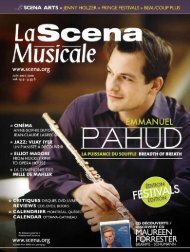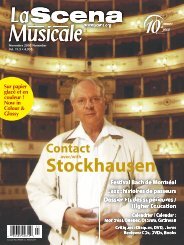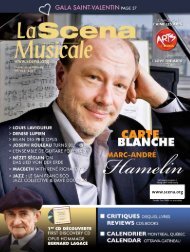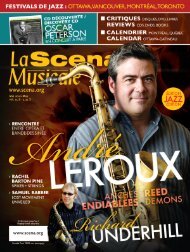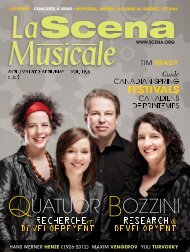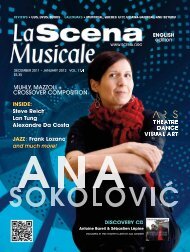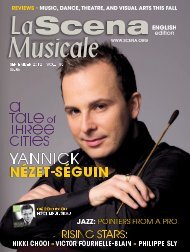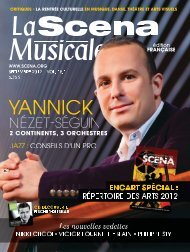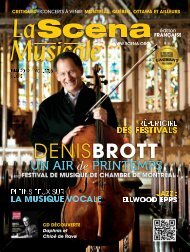Create successful ePaper yourself
Turn your PDF publications into a flip-book with our unique Google optimized e-Paper software.
virtuose auquel ces Préludes se prêtent<br />
trop facilement. S’il y a virtuosité, elle est<br />
dans la discipline qu’il impose à une main<br />
gauche qui sait se plier avec souplesse aux<br />
desseins souvent complexes que l’imagination<br />
du compositeur lui impose. Son<br />
accompagnement déroule un tapis sonore<br />
somptueux mais toujours discret pour<br />
porter et mettre en valeur les mélodies. Le<br />
pianiste calibre ses effets dynamiques en<br />
équilibrant avec goût, puissance et justesse<br />
expressives. Il suffit de comparer avec<br />
l’enregistrement quelque peu surfait<br />
d’Ashkenazy (Decca, 1976, 1995) pour<br />
mesurer cette réussite. On pourrait même,<br />
à certains égards - une très belle prise de<br />
son, par exemple - préférer Berezovsky à<br />
Weissenberg (RCA, 1971) qui tenait jusqu’à<br />
présent, et à bon droit, le haut du pavé. A L<br />
Capital BrassWorks<br />
From Russia with Brass<br />
Arrangements de pièces de Khatchaturian, Rimsky-<br />
Korsakov, Glière, Rachmaninov, Tchaikovsky, Borodin<br />
et Moussorgsky<br />
CBC Records SMCD 5235<br />
(67 min 19 s)<br />
★★★★✩✩ $$<br />
Ensemble de cuivres<br />
fondé en 1999 et principalement<br />
composé de<br />
musiciens de la région<br />
d’Ottawa, Capital Brass-<br />
Works en est à son deuxième disque. “From<br />
Russia with Brass” est entièrement constitué<br />
d’arrangements de pièces de compositeurs<br />
russes (qui avaient dans certains cas<br />
déjà donné lieu à de tels arrangements) :<br />
Danse du sabre de Khatchaturian, extraits<br />
de la Suite Casse-noisette de Tchaïkovsky,<br />
Tableaux d’une exposition de Moussorgsky,<br />
etc. Les instrumentistes sont bons, les<br />
arrangements (de Colin Traquair et Angus<br />
Armstrong, deux trombonistes de l’ensemble)<br />
sont généralement bien réalisés, la<br />
sonorité est toujours de qualité, la justesse<br />
presque toujours impeccable, les attaques<br />
précises… mais l’interprétation pourrait<br />
avoir plus de personnalité. <strong>La</strong> direction du<br />
Capital BrassWorks est assurée par l’organiste<br />
Thomas Annand, qui devrait insuffler<br />
plus de relief au jeu des musiciens et<br />
accorder plus d’attention aux détails de la<br />
partition. Dans les Tableaux, par exemple,<br />
“Gnomus”, noté sempre vivo, est plutôt<br />
balourd et on n’y perçoit pas de contraste<br />
entre les passages vivo et ceux marqués<br />
poco meno mosso pesante; dans “Tuileries”<br />
les variations de tempo sont également<br />
presque inexistantes. Quand même un<br />
disque qui fait forte impression. IP<br />
Dernières Sonates<br />
Beethoven : Sonate op. 111 n o 32;<br />
Schubert : Sonate D 960 n o 21<br />
Zhu Xiao-Mei, piano<br />
Mandala MAN 5085 (66 min 45 s)<br />
★★★✩✩✩ $$$<br />
Zhu Xiao-Mei avait séduit par son interprétation<br />
des Variations Goldberg et des<br />
60 septembre 2005 september<br />
Sonates de Scarlatti,<br />
d’une calme limpidité.<br />
Les admirateurs de la<br />
pianiste chinoise risquent<br />
cette fois d’être<br />
déçus par son plus<br />
récent enregistrement<br />
qui inclut deux œuvres<br />
autrement difficiles du répertoire. On<br />
pourrait les qualifier de testamentaires<br />
puisqu’il s’agit de la dernière Sonate de<br />
Beethoven et de Schubert. Bien que bonne<br />
technicienne, la pianiste ne semble pas<br />
maîtriser les difficultés de l’opus 111, s’il faut<br />
en croire les confusions (dues en partie à la<br />
réverbération ?) et l’instabilité rythmique du<br />
premier mouvement. Dans le Maestoso<br />
introductif, les croches doublement<br />
pointées et les triples croches ne sont pas<br />
exécutées avec la précision rythmique indispensable.<br />
Quant au second mouvement, il<br />
s’étale sans poésie ni mystère ; les triolets et<br />
les trilles laborieusement exécutés de la<br />
dernière variation s’écrasent au lieu de<br />
s’envoler. Le problème est différent avec<br />
Schubert. Tout au long des deux premiers<br />
mouvements, l’on ne ressent guère la suspension<br />
du temps que Schubert y propose<br />
comme équivalent de l’infini à l’approche de<br />
la mort. <strong>La</strong> pianiste tente d’y suppléer par un<br />
lyrisme étudié et la recherche de quelques<br />
beaux détails. Le trio central du Scherzo est<br />
plutôt lourdaud et le dernier mouvement,<br />
mieux enlevé, arrive trop tard. AL<br />
MUSIQUE ORCHESTRALE/<br />
ORCHESTRAL MUSIC<br />
Ludwig van Beethoven: Symphony N o 9<br />
Maria Stader (soprano), Katharina Marti (contralto),<br />
Waldemar Kmett (tenor), Heinz Rehfuss (bass),<br />
L’Union chorale de <strong>La</strong>-Tour-de-Peilz,<br />
Chœur de Chailly-sur-Clarens,<br />
Orchestra Nationale / Carl Schuricht<br />
Music & Arts CD-1166 (66 min 03 s)<br />
★★★✩✩✩ $$$<br />
Anna Tomowa-Sintow (soprano), Annelies<br />
Burmeister (mezzo-soprano), Peter Scheier (tenor),<br />
Theo Adam (bass), Radio Choir Leipzig,<br />
Gewandhausorchester Leipzig/Kurt Masur<br />
PentaTone 5186 146 (68 min 32 s) Hybrid SACD<br />
★★★★✩✩ $$$$<br />
Carl Schuricht’s standing<br />
in the musical profession<br />
can be judged by the fact<br />
that he was only the second<br />
conductor (after Furtwängler)<br />
to be granted<br />
honourary membership in<br />
the Vienna Philharmonic Orchestra. Schuricht<br />
(1880 - 1967) is the subject of a revival on<br />
record from a number of labels (including a<br />
four-disc box from Music & Arts - CD 1094).<br />
The present issue is taken from the broadcast<br />
tapes of a live performance from the Montreux<br />
Festival of 1954. It is a fine account with a<br />
strong rhythmic profile and vigorous accentuation<br />
that will appeal to historically-minded collectors.<br />
It also provides a memorable platform<br />
for some grand old singers who are obligingly<br />
close-miked. Restoration of the mono sound<br />
by Aaron Z. Snyder is of high quality.<br />
The PentaTone label is new to Canada. It<br />
specializes in Hybrid Super Audio CDs<br />
although the bulk of the catalogue dates from<br />
the 1970s. These re-issues (including Masur’s<br />
complete Beethoven symphony cycle) were<br />
originally recorded in four-channel quadraphonic<br />
sound, and PentaTone allows us to hear<br />
them (on a multi-channel system) as they were<br />
intended to be heard. Consequently, the new<br />
set is preferable to the existing bargain reissues<br />
of the same material in the Philips Duo<br />
series. The performance of the Ninth is excellent<br />
and truly distinctive for its provenance.<br />
Leipzig possessed one of the last great, purely<br />
German orchestras (literally) in captivity. This<br />
confers a strong cohesive tradition on the<br />
music and makes for a remarkable discipline<br />
among the musicians. Yet this natural, freely<br />
flowing and expressive account was recorded<br />
fifteen years before Kurt Masur threw open the<br />
doors of the Gewandhaus to shelter prodemocracy<br />
demonstrators during the tumultuous<br />
ten-week revolution in the German<br />
Democratic Republic. The opportunity to<br />
record for a foreign label in 1974 was seized as<br />
a path through the barbed wire and minefields<br />
of the inner German border, the break needed<br />
to communicate with the free world. This<br />
added dimension of subliminal resistance<br />
needs to be remembered and factored into our<br />
understanding of the music... and nowhere to<br />
greater effect than Symphony No 9.<br />
Two further installments of the Masur cycle<br />
were auditioned: the combinations of Nos 3<br />
and 8 (5186 144) and Nos 4 and 7 (5186<br />
145). These were sufficiently impressive to justify<br />
an immediate investment in the remainder<br />
of the set – courageous performances in<br />
superb sound. WSH<br />
Anton Bruckner: Symphonies Nos 3, 7 and 8<br />
Symphony No 3: Symhponieorchester des<br />
Bayerischen Rundfunks/Klaus Tennstedt<br />
Profil PH04093 (52 min 10 s)<br />
★★★✩✩✩ $$$$<br />
Symphony No 7: Wiener Symphoniker/<br />
Yakov Kriesberg<br />
PentaTone 5186 051 (67 min 54 s) Hybrid SACD<br />
★★★★★✩ $$$$<br />
Symphony No 8: Royal Concertgebouw<br />
Orchestra/Bernard Haitink<br />
RCO Live RCO 05003 (85 min 45 s) Hybrid SACD<br />
★★★★✩✩ $$$<br />
The sovereign virtue of<br />
Herbert von Karajan’s<br />
recordings of the first<br />
three numbered Bruckner<br />
symphonies (for DG) is<br />
his command of architecture<br />
and sense of proportion.<br />
There is no tendency to invest the early<br />
works with the majestic dimension of those<br />
that followed. In this live recording taken from<br />
a 1976 broadcast, Klaus Tennstedt takes a<br />
hyper-inflated, fire-and-brimstone view of the<br />
Third. The Wagnerian themes are thundered<br />
out at the expense of the contrasts and even<br />
the shrill audio source seems entirely appro-


